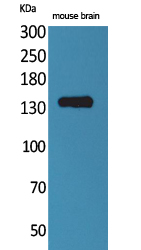Contactin 1 Polyclonal Antibody
- Catalog No.:YT5122
- Applications:WB;ELISA
- Reactivity:Human;Mouse;Rat
- Target:
- Contactin 1
- Fields:
- >>Cell adhesion molecules
- Gene Name:
- CNTN1
- Protein Name:
- Contactin-1
- Human Gene Id:
- 1272
- Human Swiss Prot No:
- Q12860
- Mouse Gene Id:
- 12805
- Mouse Swiss Prot No:
- P12960
- Rat Gene Id:
- 117258
- Rat Swiss Prot No:
- Q63198
- Immunogen:
- Synthesized peptide derived from the N-terminal region of human Contactin 1.
- Specificity:
- Contactin 1 Polyclonal Antibody detects endogenous levels of Contactin 1 protein.
- Formulation:
- Liquid in PBS containing 50% glycerol, 0.5% BSA and 0.02% sodium azide.
- Source:
- Polyclonal, Rabbit,IgG
- Dilution:
- WB 1:500 - 1:2000. ELISA: 1:20000. Not yet tested in other applications.
- Purification:
- The antibody was affinity-purified from rabbit antiserum by affinity-chromatography using epitope-specific immunogen.
- Concentration:
- 1 mg/ml
- Storage Stability:
- -15°C to -25°C/1 year(Do not lower than -25°C)
- Other Name:
- CNTN1;Contactin-1;Glycoprotein gp135;Neural cell surface protein F3
- Observed Band(KD):
- 113kD
- Background:
- The protein encoded by this gene is a member of the immunoglobulin superfamily. It is a glycosylphosphatidylinositol (GPI)-anchored neuronal membrane protein that functions as a cell adhesion molecule. It may play a role in the formation of axon connections in the developing nervous system. Multiple alternatively spliced transcript variants encoding different isoforms have been found for this gene. [provided by RefSeq, Dec 2011],
- Function:
- disease:Defects in CNTN1 are the cause of Compton-North congenital myopathy [MIM:612540]. Compton-North congenital myopathy is a familial lethal form of congenital onset muscle weakness, inherited in an autosomal-recessive fashion and characterized by a secondary loss of beta2-syntrophin and alpha-dystrobrevin from the muscle sarcolemma, central nervous system involvement, and fetal akinesia.,function:Contactins mediate cell surface interactions during nervous system development. Involved in the formation of paranodal axo-glial junctions in myelinated peripheral nerves and in the signaling between axons and myelinating glial cells via its association with CNTNAP1. Participates in oligodendrocytes generation by acting as a ligand of NOTCH1. Its association with NOTCH1 promotes NOTCH1 activation through the released notch intracellular domain (NICD) and subsequent translocation to the nucl
- Subcellular Location:
- [Isoform 1]: Cell membrane; Lipid-anchor, GPI-anchor; Extracellular side.; [Isoform 2]: Cell membrane; Lipid-anchor, GPI-anchor; Extracellular side.
- Expression:
- Strongly expressed in brain and in neuroblastoma and retinoblastoma cell lines. Lower levels of expression in lung, pancreas, kidney and skeletal muscle.
- June 19-2018
- WESTERN IMMUNOBLOTTING PROTOCOL
- June 19-2018
- IMMUNOHISTOCHEMISTRY-PARAFFIN PROTOCOL
- June 19-2018
- IMMUNOFLUORESCENCE PROTOCOL
- September 08-2020
- FLOW-CYTOMEYRT-PROTOCOL
- May 20-2022
- Cell-Based ELISA│解您多样本WB检测之困扰
- July 13-2018
- CELL-BASED-ELISA-PROTOCOL-FOR-ACETYL-PROTEIN
- July 13-2018
- CELL-BASED-ELISA-PROTOCOL-FOR-PHOSPHO-PROTEIN
- July 13-2018
- Antibody-FAQs
- Products Images

- Western Blot analysis of mouse brain cells using Contactin 1 Polyclonal Antibody. Secondary antibody(catalog#:RS0002) was diluted at 1:20000



